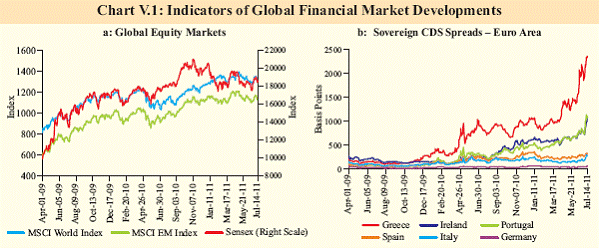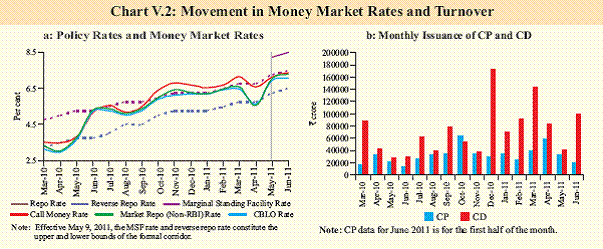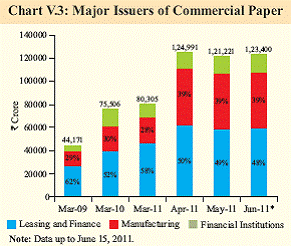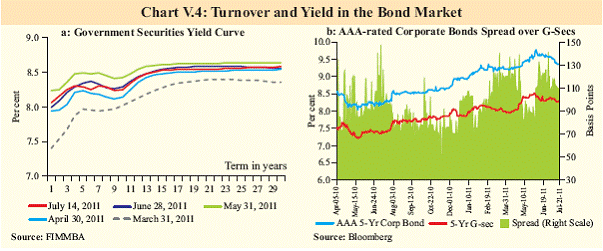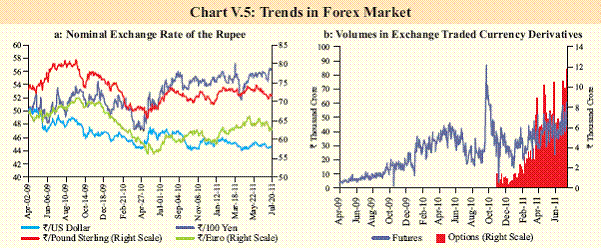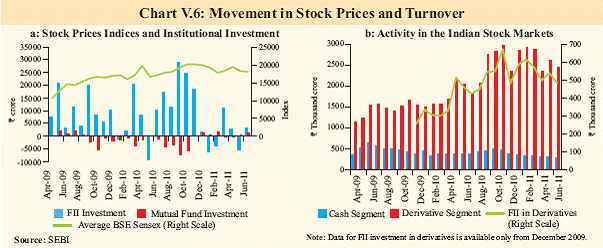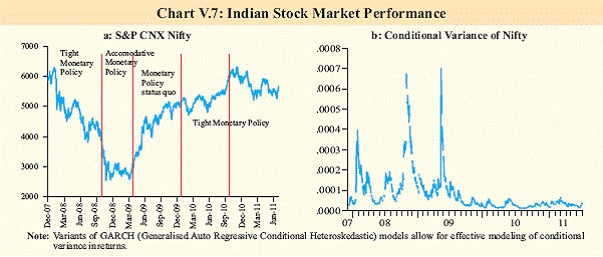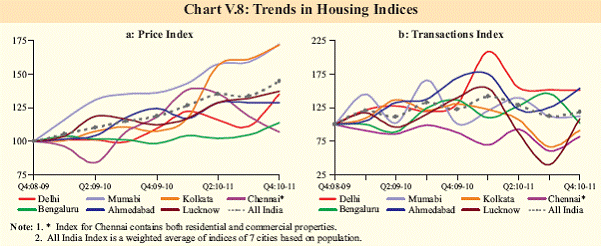V. Financial Markets - RBI - Reserve Bank of India
V. Financial Markets
Interest rates generally firmed up further across the spectrum during Q1 of 2011-12 as monetary transmission strengthened in a liquidity deficit mode. Equity markets remained sluggish but rallied towards the end of the quarter with valuations turning attractive. The Rupee exhibited two-way movement. Financial asset prices generally remained range bound, though property prices stayed on up-course in Q4 of 2010-11. Going forward, the possibility of delayed exit from monetary easing by advanced economies, sovereign default risks in the Euro zone and the possibility of rating downgrades for major economies will have ramifications for capital flows and financial markets. Global financial market conditions remained tepid in Q1 of 2011-12 V.1 Global financial markets were generally in a corrective mode since end-April 2011 (Chart V.1a). Stagnant real estate markets, high unemployment and weak sovereign balance sheets in Advanced Economies (AEs) continue to pose major concerns for the financial markets. In the IMF June 2011 Market Update of the Global Financial Stability Report, a rise in the financial risks was reported due to (i) downside risks to the multi-speed recovery baseline; (ii) concern about debt sustainability in Europe’s periphery; and (iii) “search for yield” pushing investors into riskier assets. The flattening of yield curves in both AEs as well as Asian Emerging Market Economies (EMEs), particularly since end-March 2011 suggest moderation in economic growth, albeit differentially, during 2011-12. Widening credit spreads, rating downgrades reflect micro and macro prudential risks V.2 On an average, credit spreads widened during Q1 of 2011-12 as balance sheet risks came to fore. Sovereign Credit Default Swap (CDS) spreads rose sharply in the Euro Area following the accentuation of the Greek debt crisis and the indications that the crisis may spread from periphery to some core Euro zone countries (Chart V.1b). Rating downgrades or downward revision of outlook in case of the US, Japan, Spain and Italy impacted financial market confidence that were reflected in widening spreads. Amplification of refinancing risks in Greece and Portugal and the sharp fournotch downward revision by Moody’s of Portugal’s credit rating to junk status with a negative outlook in early July reconfirmed the Euro zone fragilities.
V.3 Recapitalisation of the banking system in the fragile Euro zone countries is the most important element of an enduring Euro zone solution. The stress tests conducted by the European Banking Authority (EBA) have not succeeded in restoring confidence amongst investors and creditors. The EU needs to deal with capital shortfalls for banks that fail stress tests, but market access is limited for weaker sovereigns like Greece, Portugal and Ireland. On the other hand, with hardly any fiscal space and the potential moral hazard risk from bailouts, the solution is not easy. Euro zone risks may lead to global financial market volatility. Financial risks increased while interest rates softened V.4 While interest rates are firming up in the Indian economy, global financial markets witnessed rising financial risks and softening interest rates in Q1 of 2011-12. Libors for 1- month to 1-year tenors edged down marginally even from the low prevailing rates. G-sec yields across maturity spectrum eased by 30-50 bps in 5-10 year segment for the US, the UK and Germany. Falling interest rates co-existed with (1) policy rate hikes by some AE central banks, most notably by the ECB in April and again in July, (2) rising sovereign and credit spreads and (3) inflation in the AEs with escalating energy and food prices that have spilled over to rising producer price and headline inflation. It remains to be seen whether the movements in interest rates reflect temporary overreaction or are on the basis of expectations of future global growth. Indian financial markets remain orderly and range bound V.5 Even as domestic and global factors resulted in two-way movements in the Indian financial markets, asset price movements remained broadly range-bound and orderly. This was despite the challenges posed by persistent inflation, tight liquidity conditions and uncertainty in the international markets on account of Greek sovereign debt crisis and slowdown in AEs. V.6 The call rate declined in the beginning of Q1 of 2011-12 on the backdrop of surplus liquidity, but firmed up thereafter, in step with policy rate hikes since May 2011. The interest rates on commercial paper (CP) and Certificates of Deposit (CDs) moved in tandem with the overnight money market rates. The yield curve for Government securities (G-sec) shifted upwards during the first two months of the quarter in line with the policy rate hike, but moderately shifted downwards in June 2011.
V.7 Stock prices fell during Q1 of 2011-12, albeit at a lesser pace than that of other BRIC nations, influenced by domestic and global concerns. There was, however, some rally towards the end of the quarter due to FII inflows. The P-E ratio of Indian equities was higher than those of other BRIC nations (Table V.1). On a quarter-on-quarter basis, prices in the housing market firmed up during Q4 in majority of cities tracked by the Reserve Bank after showing signs of moderation during Q3 of 2010-11. Money market rates firm up on tight liquidity and rate hikes but do not exhibit signs of stress V.8 Short-term rates moved up further, but there were no signs of stress in money markets. The interest rate movement tracked the 75 bps repo rate hike during the quarter and the tight liquidity conditions. Monetary transmission strengthened further during Q1 of 2011-12. The call rate, which had declined in April 2011 on the back of easing of liquidity conditions, firmed up thereafter, in response to the increase in the repo rate in May and June 2011 (Chart V.2a, Table V.2). The rates in the collateralised segments (i.e., CBLO and market repo) moved in tandem with the call rate, but generally remained below it.
V.9 Transaction volumes in the CBLO and market repo segments were higher during the Q1 of 2011-12 than in the preceding quarter (Table V.3). During the quarter, banks and primary dealers were the major groups of borrowers in the collateralised segments whereas mutual funds (MFs) contributed nearly three-fourth of the total lending in CBLO, and more than half in market repo segment. The collateralised segment of the overnight money market remained dominant, accounting for more than 80 per cent of the total volume during Q1 of 2011-12. V.10 With from strong growth in retail deposit mobilisation, banks offered a relatively lower rate of interest on CDs during 2011-12 so far (up to June 17) compared with the previous quarter. The CD issuance declined in Q1 of 2011-12. In contrast, the CP issuance increased. The ‘leasing and finance’ and ‘manufacturing companies’ were the major issuers of CPs (Chart V.2b, V.3). V.11 Primary yields on Treasury Bills (TBs) firmed up during Q1 of 2011-12 in line with the spike in short-term interest rates (Table V.4). The rise in yields reflected a sharp increase in Government short-term borrowing, through issuances of TBs over and above the amount as per the indicative calendar announced in March 2011 as also through issuances of Cash Management Bills (CMBs) to meet the unanticipated sharp cash flow mismatches, particularly, in the wake of large tax refunds.
Yield curve flattens with sharper rise at the short end V.12 Reflecting the larger than anticipated issuances of TBs and CMBs by the Government, and the higher than expected hike in the Reserve Bank’s policy rate in May 2011, the G-sec yield curve shifted up, particularly at the short end, flattening the yield curve. The rise in yields across the maturity spectrum also reflected the increase in the global commodity prices, including crude oil, and persistent high inflation. The yield curve, however, moved downward thereafter in the wake of growth concerns and moderation in crude oil prices (Chart V.4a).
V.13 In the context of inflationary pressures and tight liquidity conditions, the primary market yields moved up. The weighted average yield in primary auctions firmed up during Q1 of 2011-12 (Table V.5). The investor sentiment, however, was largely sustained. The bid-cover ratio stood in the range of 1.39-3.20 during Q1 of 2011-12 as against 1.39-3.87 during the corresponding quarter of the previous year. In view of the flattening yield curve, more long dated securities were issued and accordingly, the weighted average maturity of the dated securities issued during Q1 of 2011-12 increased. V.14 During 2011-12 so far (up to July 15, 2011), 13 States raised `31,773 crore on a gross basis as compared with `28,210 crore raised during the corresponding period of 2010-11. V.15 The spreads of 5-year corporate bonds over comparable G-secs decreased during May 2011, reflecting the impact of unanticipated increase in Government shortterm borrowing. The spreads increased in June mainly reflecting the hardening of corporate bond yields (Chart V.4b). Monetary transmission strengthens with rates hardening in the credit market V.16 Monetary policy transmission to credit market strengthened further during Q1 of 2011- 12 as banks increased their deposit and lending rates in response to the increase in the policy rate by the Reserve Bank (Table V.6). During Q1 of 2011-12, deposit rates of banks were increased in the range of 10-300 basis points (bps) across all maturities. Twenty-three major banks accounting for around 65 per cent of the total bank deposits raised their deposit rates in the range of 25-175 bps. The rise in deposit rates was relatively sharper for maturities up to 1 year for all categories of banks. As savings account deposits constitute around a quarter of total deposits, the 50 bps hike in the savings deposit rate also increased the cost of funds for the banks. During the quarter, all scheduled commercial banks increased their Base Rates in the range of 25-225 bps, of which 47 major banks with a credit share of around 98 per cent raised their Base Rates by 50-125 bps.
Exchange rate remains flexible with less volatility V.17 During 2011-12 so far (up to July 20, 2011), the rupee appreciated marginally against all major currencies barring the Japanese Yen, reflecting in part the dollar’s movement in the international currency markets due to uncertainty of growth prospects in the US (Chart V.5a). The average daily turnover in the interbank segment of the foreign exchange market was higher while it was lower in the merchant segment than that in the preceding quarter. The 1-month, 3-month as well as 6-month forward premia declined significantly during the quarter, reflecting an increased supply by exporters in the forward market. The Reserve Bank did not intervene in the forex market during 2011-12 so far. V.18 The average daily turnover in the exchange traded currency derivatives grew by 1.7 per cent when compared with the negative growth of 2.8 per cent in the previous quarter (Chart V.5b). Options recorded a higher growth rate than futures. In the OTC currency derivatives, the swap segment continued to dominate. The average daily turnover in the OTC market grew by around 14.8 per cent during Q1 of 2011-12 as compared with a negative growth of 3.7 per cent during the previous quarter.
Equity markets remained sluggish and less volatile V.19 Volatility in equity markets declined substantially in the post-crisis period. This declining trend continued into Q1 of 2011-12. Although, in relative terms, the performance of the Indian equity markets was better than that of other BRIC nations during Q1, the two key indices, Sensex and Nifty, declined by about 3 per cent (Table V.7). Rising crude oil prices, persistently high inflation, successive policy rate hikes by the Reserve Bank, domestic political developments and the worsening Greek sovereign debt crisis affected market sentiment negatively. Net investment by FIIs in equity and debt segments was US$ 1.0 billion during Q1 of 2011-12, of which flows to equity market amounted to US$ 0.8 billion (Chart V.6). Equity markets, however, rallied towards end-June with a revival in FII investments.
V.20 Stock price returns are affected by stock return volatility, and the extent of impact depends crucially on the permanence of shocks to the variance in returns. An analysis of the returns from the broad based S&P CNX Nifty index against the backdrop of the financial crisis and monetary policy action demarcates the time varying volatility persistence in the returns data (Chart V.7 a and b). The variability in returns, controlling for all other past factors, shows a sharp decline from the crisis period and appears to be moderating. V.21 Turnover in the equity derivatives segment constituting almost 90 per cent of the overall investments, witnessed some moderation during Q1 of 2011-12. Volatility in Nifty index options as measured by the India Volatility Index (VIX) was lower in Q1 of 2011- 12 than Q4 of 2010-11. V.22 The resource mobilisation in the primary segment of the domestic capital market through public issues was lower during Q1 of 2011-12 than the corresponding quarter of the previous year (Table V.8). Poor performance of the IPOs after their listing affected investor and promoter sentiments.
V.23 Resource mobilisation by mutual funds during April-June 2011 was higher than that during the corresponding period of the previous year, although there were net outflows during May-June 2011, particularly in debt mutual funds. The increase in dividend distribution tax for non-retail investors in liquid/debt mutual funds effective from June 1, 2011 and the cap of 10 per cent of net worth placed on banks’ investment in liquid/debt funds which will be made effective over a six-month period beginning July 5, 2011, could have affected flows into debt mutual funds.
Housing prices and transaction volumes rise in Q4 of 2010-11 V.24 Property prices increased during 2010-11, despite firming up of mortgage rates. The Reserve Bank’s Quarterly House Price Index (HPI) based on data in respect of seven cities collected from the Department of Registration and Stamps (DRS) of the respective State Governments show that house prices in five of the seven major cities were higher on a quarterover- quarter basis in Q4 of 2010-11, but were flat in Ahmedabad and had continued to fall in Chennai (Chart V.8). The data on volume of transactions show that after stalling in Q3, transactions increased during Q4 of 2010-11. On a year-on-year basis, there has been an increase in housing prices in Q4 in six cities (i.e., barring Chennai). Housing transactions, however, fell in five of the seven cities (i.e., barring Delhi and Mumbai). Market volatility could resurface if macro conditions deteriorate V.25 The subdued current market volatility is no guidance for future. Financial market volatility can return if macro conditions worsen. V.26 Indian financial markets would continue to be influenced by the global as well as domestic factors. Money market rates would continue to be conditioned by monetary policy actions. If prolonged inflation feeds into inflationary expectations, it would affect all segments of the markets, particularly the G-sec markets. A widening of the fiscal deficit leading to a higher than budgeted market borrowings could also exert upward pressure on G-sec yields. A slowdown in economic growth could affect corporate performance which, in turn, would weigh on equity markets.
|
||||||||||||||||||||||||||||||||||||||||||||||||||||||||||||||||||||||||||||||||||||||||||||||||||||||||||||||||||||||||||||||||||||||||||||||||||||||||||||||||||||||||||||||||||||||||||||||||||||||||||||||||||||||||||||||||||||||||||||||||||||||||||||||||||||||||||||||||||||||||||||||||||||||||||||||||||||||||||||||||||||||||||||||||||||||||||||||||||||||||||||||||||||||











